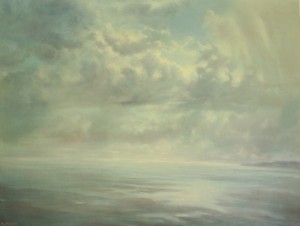By Ron Mulvey
The real trick for displaying your art is to find a light that complements the light in your painting.
Low chroma paintings (dark intense, somber) do not require much light. The contemporary landscape artist has designed the low chroma painting to bring out the dark colors and so to display it in bright light is to ruin the overall effect. The opposite is true for bright and colorful pictures. They have been designed to be full of light–and so, they require more light than a dark, intense picture.
In other words, remember that artists work with light–your lighting, then, should work to compliment the painting.
Low chroma versus high
It is a personal preference of mine to look at my low chroma pictures (dark, somber) later at night with a small amount of indirect light or a soft spotlight and enjoy the deep saturated colors as they create a mood in the picture that is not so evident during the bright daylight.
A high chroma (bright, colourful) picture responds well to a higher light level in most cases and may work well in brightening up a wall space that is in a darker part of a room.
If you want to prove conclusively the worst lighting possible for a work of fine art take it outside at noon into the bright sunlight. It will appear washed out and garish. This is your real starting point: it is the worst light; even the Mona Lisa wouldn’t stand up to this test.
What’s the correct viewing distance for displaying paintings?
To observe a work of fine art properly as the artist did when creating it multiply the dimension at the bottom of the picture by 6. If the bottom is 24 inches you should stand back 6×24 or if my math is correct-12 feet which is roughly 4 regular steps back from the picture.
Rembrandt (the Dutch Master) told clients not to get to close to his pictures because they might not like the smell of the paint. His pictures were encrusted with a rich thick impasto in specific areas and critics denounced this crass effect saying, “the paint is so thick that you can grind nutmeg on it.”
Rembrandt’s Impasto method was not appreciated by the critics because their viewing distance was much too close. Rembrandt’s genius can only be appreciated when the eye mixes the color at the proper viewing distance. Up close it looks coarse.
How to display realistic paintings versus abstract art
The smooth flawless realistic painting demands our scrutiny up close–so don’t hide it up out of reach of your nose. Instead, place it in an intimate corner and allow viewers enough space to inspect it at several different viewing distances.
In contrast, a big bold abstract needs a buffer of air with lots of viewing distance. Don’t give much opportunity for the viewer to get up close. With abstract art, the effect is appreciated from a distance and there is not much reason going on up close for the viewer to see.
The problem of displaying art within glass
The last lighting effect to consider is the reflected light that is caused by artwork under glass and high to medium gloss finishes on canvas or panel board.
The glass protects the art work from insects, finger prints, sneezes and so on. The gloss or semi gloss finish on canvass and panel board effectively accomplishes the same function as glass: both can be very annoying when it comes to lighting the painting.
The surface glare can be minimized by not having a light source directly opposite the work such as a window or lights. Direct light creates glare.
The use of non glare glass is not advisable as it obscures the picture image and increases ultra violet damage. There are finishes for oil and acrylic paintings that produce an eggshell finish that has little or no glare.
The old idea of putting a shiny finish on artwork should be stopped. It is not necessary since paint science is at the cutting edge of technology every stoke of the way.
The shiny finish is used to enhance the colors and at times to cover up poor painting techniques where colors have sunk in or lost there lustre. A well painted oil needs very little shine on top the natural oil mediums produce a wonderful sheen that needs only a very thin protective varnish. Some artists will not object to putting a light top coat of U.V.protective spray to take down the glaring high gloss reflective finish. All finishes are designed to be removed easily but don’t do it yourself (out of respect for the artist).
Halogen lights are the best
Finally, halogen lights are the choice of the PhD’s in lighting science next to indirect natural light in combination with the halogens or incandescent.
Some further reading on art lighting
“Art Lighting Advice from a Museum Curator”
“Advice on Displaying and Caring for Your Art.”
About the Author
Ron is a contemporary landscape artist. You can view and buy his landscape paintings in his online art gallery.
Looking for an inexpensive piece of art? Ron offers beautiful, original landscape paintings for just $40. You can view and order these small paintings here.

Leave a Comment